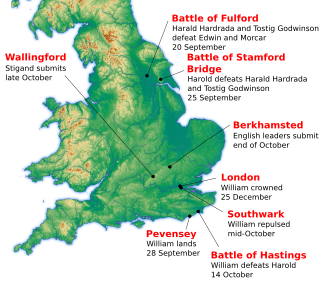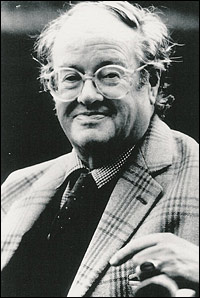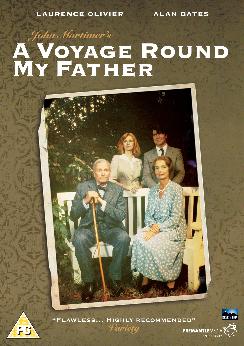| "A Choice of Kings" | |
|---|---|
| ITV Play of the Week episode | |
| Directed by | John Frankau |
| Written by | John Mortimer |
| Original air date | 11 October 1966 |
| Running time | 65 minutes |
"A Choice of Kings" is a television drama film and stage play by John Mortimer. It was first produced in 1966 in the ITV Play of the Week series, directed by John Frankau, starring Michael Craig.
The action is set at the court of Edward the Confessor, two years before the Battle of Hastings, and offers an unexpected explanation of the background to the quarrel between Harold Godwinson and William the Conqueror and the Norman invasion of England.
The first production, by Rediffusion, was timed to commemorate the 900th anniversary of the Battle of Hastings, fought on 14 October 1066 [1] and was first broadcast on 11 October, in the week of the original battle. [2]
John Mortimer's script was published in Playbill 3 (1966), together with other screenplays by Alan Plater, Ray Jenkins, Ronald Duncan, and Alan Gosling. [3] Having been published, the screenplay is sometimes performed on stage. There was a production by Ampleforth College in 1974. [4]
A review in the Birmingham Daily Post commented ”John Mortimer's play A Choice of Kings (ITV, Tuesday) was dead as a drama, but half revived by its whimsical touches. [5] The Liverpool Echo drew attention to a minor detail, ”For Harold, as can be seen to-night on ITV in a new John Mortimer play, A Choice of Kings, was vain enough to wear a Diana Dors bob of golden shoulder-length hair. [2]

1066 (MLXVI) was a common year starting on Sunday of the Julian calendar, the 1066th year of the Common Era (CE) and Anno Domini (AD) designations, the 66th year of the 2nd millennium and the 11th century, and the 7th year of the 1060s decade. As of the start of 1066, the Gregorian calendar was 6 days ahead of the Julian calendar, which was the dominant calendar of the time.

Harold Godwinson, also called Harold II, was the last crowned Anglo-Saxon English king. Harold reigned from 6 January 1066 until his death at the Battle of Hastings on 14 October 1066. It was the decisive battle of the Norman Conquest. Harold's death marked the end of Anglo-Saxon rule over England. He was succeeded by William the Conqueror.

The Battle of Stamford Bridge took place at the village of Stamford Bridge, East Riding of Yorkshire, in England, on 25 September 1066, between an English army under King Harold Godwinson and an invading Norwegian force led by King Harald Hardrada and the English king's brother Tostig Godwinson. After a bloody battle, both Hardrada and Tostig, along with most of the Norwegians, were killed. Although Harold Godwinson repelled the Norwegian invaders, his army was defeated by the Normans at Hastings less than three weeks later. The battle has traditionally been presented as symbolising the end of the Viking Age, although major Scandinavian campaigns in Britain and Ireland occurred in the following decades, such as those of King Sweyn Estrithson of Denmark in 1069–1070 and King Magnus Barefoot of Norway in 1098 and 1102–1103.

The Norman Conquest was the 11th-century invasion and occupation of England by an army made up of thousands of Norman, French, Flemish, and Breton troops, all led by the Duke of Normandy, later styled William the Conqueror.
Tostig Godwinson was an Anglo-Saxon Earl of Northumbria and brother of King Harold Godwinson. After being exiled by his brother, Tostig supported the Norwegian king Harald Hardrada's invasion of England, and was killed alongside Hardrada at the Battle of Stamford Bridge in 1066.

Sir John Clifford Mortimer was a British barrister, dramatist, screenwriter and author. He is best known for short stories about a barrister named Horace Rumpole, adapted from episodes of the TV series Rumpole of the Bailey also written by Mortimer.

The Battle of Fulford was fought on the outskirts of the village of Fulford just south of York in England, on 20 September 1066, when King Harald III of Norway, also known as Harald Hardrada, a claimant to the English throne and Tostig Godwinson, his English ally, fought and defeated the Northern Earls Edwin and Morcar.
Gytha Thorkelsdóttir, also called Githa, was a Danish noblewoman. She was the wife of Godwin, Earl of Wessex, and the mother of King Harold Godwinson and Edith of Wessex, the latter of whom was the queen consort of King Edward the Confessor.

Edith of Wessex was Queen of England through her marriage to Edward the Confessor from 1045 until Edward's death in 1066. Unlike most English queens in the 10th and 11th centuries, she was crowned. The principal source on her life is a work she herself commissioned, the Vita Ædwardi Regis or the Life of King Edward who rests at Westminster, which is inevitably biased.
Morcar was the son of Ælfgār and brother of Ēadwine. He was the earl of Northumbria from 1065 to 1066, when William the Conqueror replaced him with Copsi.

Edith the Fair, also known as Edith Swanneck, was one of the wealthiest magnates in England on the eve of the Norman conquest, and may also have been the first wife of King Harold Godwinson. "Swanneck" comes from the folk etymology which made her in Old English as swann hnecca, "swan neck", which was actually most likely a corrupted form of swann hnesce, "Gentle Swan". She is sometimes confused with Ealdgyth, daughter of Earl Ælfgar of Mercia, who was queen during Harold's reign.

Gyrth Godwinson was the fourth son of Earl Godwin, and thus a younger brother of Harold Godwinson. He went with his eldest brother Sweyn into exile to Flanders in 1051, but unlike Sweyn he was able to return with the rest of the clan the following year. Along with his brothers Harold and Tostig, Gyrth was present at his father's death-bed.

Leofwine Godwinson was a younger brother of King Harold Godwinson, the fifth son of Earl Godwin.

A Voyage Round My Father is an autobiographical play by John Mortimer, later adapted for television.
Events from the 1060s in England.
William I of England has been depicted in a number of modern works.

The House of Godwin was an Anglo-Saxon family who were one of the leading noble families in England during the last fifty years before the Norman Conquest. Its most famous member was Harold Godwinson, King of England for nine months in 1066.
Michael Gerald Hastings was a British playwright, screenwriter, and occasional novelist and poet.
Fictional accounts based on the events surrounding Harold Godwinson's brief reign as king of England have been published.

An Age of Kings is a fifteen-part serial adaptation of the eight sequential history plays of William Shakespeare, produced and broadcast in Britain by the BBC in 1960. The United States broadcast of the series the following year was hosted by University of Southern California professor Frank Baxter, who provided an introduction for each episode specifically tailored for the American audience. At the time, the show was the most ambitious Shakespearean television adaptation ever made, and was a critical and commercial success in both the UK and the US. Performed live, all episodes were telerecorded during their original broadcast.